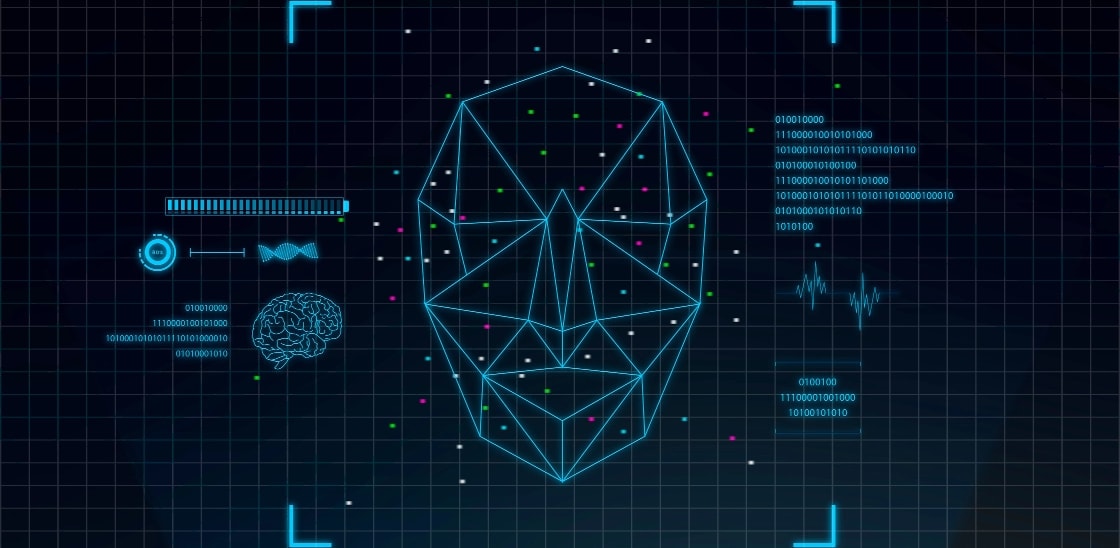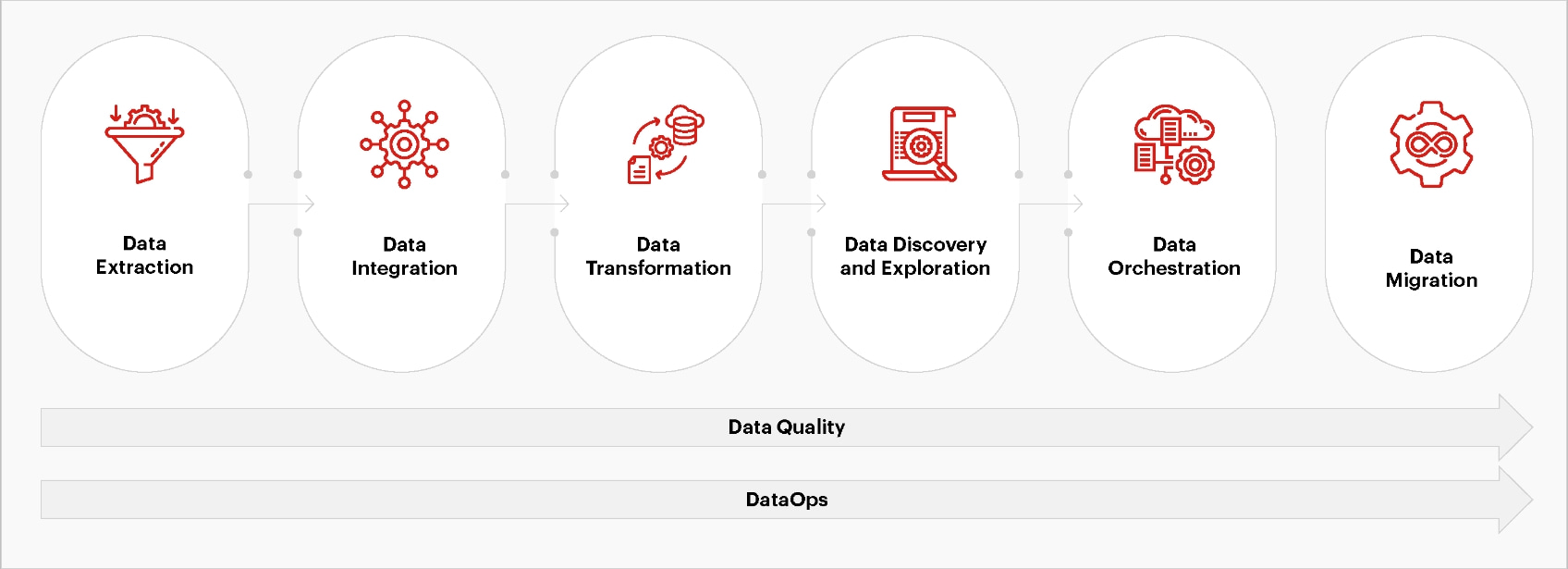The Transformative Role of Generative AI in Data Life Cycle Management
Reading Time: 6 minutes

Welcome back to our 2 part blog series on the Transformative Role of Generative AI in Data Engineering. If you haven’t had the chance to read Part 1 – The Transformative Role of Generative AI in Data Engineering, I recommend checking it out. In this blog, we will explore the remarkable possibilities that Generative AI brings to the realm of data lifecycle management. We will cover its potential applications in various stages, including data sourcing, integration, transformation, data quality assurance, data discovery, and operations.

Data Extraction:
- Web scrapping: LLMs can be used in web scraping to extract and process information from web pages. They can extract text, links and images from specific tags, understand the meaning of the text, or identify patterns in the data, and summarize it. Extracted data can be pre-processed and converted to a suitable format for further analysis.
- Schema inference & data Parsing: Generative AI models can aid in inferring data schemas, parsing and extracting relevant information from unstructured or semi-structured data sources. By training models on sample data, they can learn patterns and extract structured data elements such as entities, attributes, and relationships, helping in the transformation of raw data into a structured format for ingestion.
- Transactional data: Generative AI can extract data from articles, documents, and data marketplace, saving it to an appropriate format in the Enterprise Data Platform. E.g. extracting data from financial reports, summarizing it,’ and writing a starter code for exporting to JSON format for further analysis. Extracting transactional data from documents like invoices and receipts via various text formats including PDFs
Data Integration:
- Schema mapping and transformation: By training models on source and target data schemas, generative models can create mapping rules and transformations to align the data schemas, simplify the integration process and also develop documents for references and audits
- Entity Resolution and Matching: Generative AI can assist in entity resolution and matching tasks, which involve identifying and linking entities across different datasets.
- Data Unification and Deduplication:Training generative models on existing data enables them to learn patterns and identify duplicate or redundant records. This helps in generating rules and algorithms to merge similar records and eliminate duplicates during the data integration.
E.g. Instruction can be given to GPT-4 to copy various files from blob storage to Snowflake tables or to write PySpark code for getting CSV files from AWS S3 to an aggregated table in Redshift or to Databricks for further transformation
Data Transformation:
- Data Cleansing: LLM GPT can help identify and correct anomalies or inconsistencies within datasets. With its ability to understand and generate text, LLM GPT can assist in standardizing data formats and performing data deduplication tasks.
- Data Mapping and Transformation: By training models on source and target data schemas, Generative AI can generate mappings and transformation rules. LLMs can generate code that handles transformation tasks such as merging, formatting, or filtering data.
E.g. LLMs can be used to transform data across the medallion data flow pattern (Bronze, Silver, Gold) with an increasing level of refinement and aggregation to build various reports on Sales, Marketing, and Supply Chain/Logistics.
Help with quick validation of hypothesis by data analysts in the generating reports by generating a framework code base data transformation rules
Data Discovery & Exploration:
- Data Profiling: Generative AI can help in analyzing the data set content, structure and fetch the Meta Data, and profile it by generating descriptive summaries, statistics, and visual representations of the data of distribution.
- Data Clustering and Classification: By analyzing the features and relationships within the data, generative models can identify groups or categories, helping in identifying segments in the data sets
- Exploratory Data Visualization: Generative AI can aid in exploratory data visualization by generating different visual representation formats of the data set and aid users in interactively exploring data patterns, trends, and relationships. It can generate visual representations, such as network graphs or relationship maps, which facilitate the discovery of data relationships and dependencies.
- Anomaly/Outlier Detection: Generative AI models can assist in detecting anomalies or outliers within data sets, and flag potential outliers or anomalies that may require further investigation during data discovery.
Conversational natural language interfaces can be leveraged to create natural language interfaces for data discovery. It can interpret user queries or descriptions and retrieve relevant data or insights.
Data Orchestration:
- Workflow Automation: Generative AI can automate the generation of workflow or workflow templates by training generative models on historical data and workflow patterns. Generative models can predict and identify data dependencies across different tasks or workflows and help document the same for efficient operational procedures and are beneficial during any audit purposes
- Task Scheduling: Generative AI can assist in optimal task scheduling within data orchestration workflows by analyzing dependencies, resource constraints, and historical performance data
- Debugging, Error Handling, and Retry Mechanisms: By analyzing error logs and historical data, generative models can identify common errors and generate recommendations to handle and recover from failures. For instance, LLMs can help inspect and debug pipelines and orchestration tools like Apache Airflow or Prefect workflows.
Data Ops:
- Data Quality validation and anomaly detection:Generative AI can learn patterns and identify potential data quality issues such as missing values or inconsistencies. In DataOps practice, it helps in data pipeline monitoring for any outliers and captures the anomaly to isolate, redact, and archive those datapoints
- Automated data governance: By assisting in metadata capture, data lineage, and business rules, generative models can provide recommendations for data classification, access controls, and data privacy compliance and ensure regulatory compliance and organizational policies.
- Data pipeline optimization:By analyzing historical data, resource constraints, pipeline performance, and other dependencies, generative models can suggest optimizations such as reordering steps, parallelization, or alternative processing techniques. This helps in improving the efficiency and scalability of data processing pipelines.
Data Migration:
- Data domain documentation: Generative AI can help discover data mapping and relationships across different datasets, and schema inferences to aid in documenting the source and target data schemas. They can establish relationships and semantics of the data elements for any legacy systems where the tribal knowledge is sparse.
- Migration rationalization: They can perform log analysis, identify usage patterns, and generate a report on active vs obsolete datasets and optimize data migration both for re-platform or refactor type migration patterns
- Data quality & error handling: Generative AI can automate data quality assessment and error handling during cloud data migration by analyzing large volumes of error logs
- Post-migration validation: LLMs & Gen AI can assist in data validation and summarizing the data sets between the legacy platform and the newly migrated data platform
- Performance optimization: By analyzing historical performance data and resource utilization patterns, Generative AI can help by recommending optimal configurations and strategies for efficient cloud data migration.
Data Quality:
- Data Quality Assessment: Generative AI can analyse data patterns, its distributions, and identify anomalies, outliers, and potential data quality issues. It can flag and filter out erroneous, incomplete, and missing data to facilitate data cleansing or remediation
- Data Preprocessing:Generative AI can automate data preprocessing tasks, such as missing value imputation or feature scaling. It can predict missing values or apply data standardization techniques to ensure data consistency and quality
- Data Synthesis and Augmentation: Assist to generate synthetic data points that mimic the patterns and characteristics of the original dataset. This aids in augmenting the available data for further exploration and hypothesis validation
Conclusion
Overall, Generative AI, LLM GPT can be a valuable tool in aiding and navigating the treasure trove of potential Data engineering use cases right from data exploration, transformation, integration, pipeline orchestration, and DataOps. Initial usages will be experimented with, fine-tuned with focussed domain data, enhanced prompt engineering, and options for better governance. Data engineers will potentially leverage Gen AI-based tools to achieve operational efficiency in data management and need to embrace the pace at which this technology evolves. Enterprises using off-the-shelf Date engineering tools should get ready for more Generative AI-based features getting incorporated and embrace more conversational natural language-based interfaces in building and managing data platforms and at the same time prioritize governance to contain associated risks.
About the Author
Gunasekaran S is the director of data engineering at Sigmoid and with over 20 years of experience in consulting, system integration and big data technologies. As an advisor to customers on data strategy, he helps in the design and implementation of modern data platforms for enterprises in the Retail, CPG, BFSI and Travel domain to drive them towards becoming a data-centric organization.
Featured blogs
Subscribe to get latest insights
Talk to our experts
Get the best ROI with Sigmoid’s services in data engineering and AI
Featured blogs
Talk to our experts
Get the best ROI with Sigmoid’s services in data engineering and AI







